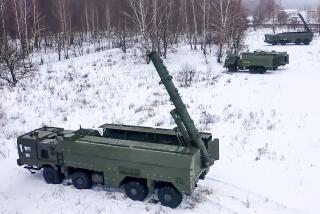This Could Be the Start of Something Big : The wisdom of pragmatism in Soviet-U.S. arms talks
- Share via
Arms races are often macabre events, but nothing is so macabre as a nuclear arms race.
That was obvious in the 1960s, when the nuclear arms race first heated up. And it’s just as obvious now, when, with the end of the Cold War, an effort is being made in both Moscow and Washington to begin to wind down the nuclear arms race.
That contest not only has its own logic, it has its own language. From “circular-error probable” to “MIRVing” and “downloading,” the world of strategic weapons speaks in a tongue of exquisite inaccessibility.
But this dense language is precisely related to the strategic calculus of assessing mutual capabilities and mutual vulnerabilities. This is a complex business at best, involving some of the best minds on either side of the superpower aisle. But the issues are so arcane that it is easy to get far removed from political reality.
THE NEW HITCH: That may be what’s happening now. The United States and the Soviet Union are at the beginning of what could be a thoroughly irreversible process of mutual reduction of tension. This historic phase offers many opportunities, especially for nuclear arms reduction, which the United States must not allow to elude its grasp.
But the U.S.-Soviet Strategic Arms Reduction Treaty (START), said to be a deal all but officially done, recently got hung up on an issue that vividly illustrates how the higher mathematics of strategic calculus can get in the way of political common sense.
The issue arises over the arming of missiles with more than one warhead. At its simplest, that technology enables one missile to deliver more than one bomb. At its most complex it enormously complicates the addition and subtraction process when both sides are proposing to reduce their nuclear force levels (by roughly half in this round of negotiations).
THE WAY OUT: Groups in both countries have been hung up over the possibility that multiple-warhead capabilities will allow either side to rearm so quickly that any reduction plan will be fraught with uncertainty--and too risky to comply with. The issue has come to revolve around the process of removing warheads from missiles--known as “downloading.” The fear is that what has been downloaded could quickly, and clandestinely, be uploaded.
But U.S. Secretary of State James A. Baker III, taking the longer view, argues that this technical hitch--and not implausible worry--should not prove an insurmountable obstacle. At stake is the positive momentum of superpower relations: Immediately at stake is a planned but unscheduled superpower summit, expected to be held later this month or next.
Baker was been working hard, both within his own government and with his Soviet counterpart, Alexander A. Bessmertnykh, the foreign minister, to finesse the downloading issue by explicitly reducing the capacity to upload. It’s a tricky business, but this is the wisest approach.
One hundred percent assurance is not possible in nuclear arms control. The only thing that’s certain is that downsizing these arsenals is an absolute necessity of American diplomacy--and of world peace.
Reducing the Threat
Comparison of intercontinental ballistic missile stockpiles of the U.S. and Soviet Union over the past decade.
United States 1980 1985 1990 Missiles 1,054 1,020 1,000 Warheads 2,150 2,120 2,450 Soviet Union Missiles 1,398 1,398 1,334 Warheads 5,000 6,420 6,280
Source: National Resources Defense Council
More to Read
Sign up for Essential California
The most important California stories and recommendations in your inbox every morning.
You may occasionally receive promotional content from the Los Angeles Times.













